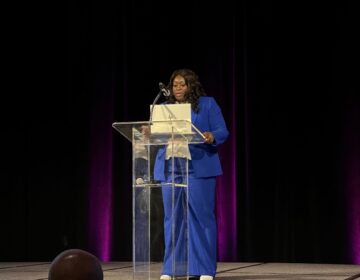Slowly, seniors in the media begin to reflect reality
On casting calls, model Rob White often wears a blue blazer to set off his blue eyes, silver hair — and white teeth.
For the last installment of our health desk series, “Gray Matters: New Tools for Growing Older,” WHYY asked a local photographer and popular 60-plus model about evolving images and perceptions of older adults.
On casting calls, model Rob White often wears a blue blazer to set off his blue eyes, silver hair — and white teeth.
“I have a nice smile, a lot of money invested in my teeth,” White said.
White, who books work through the Model Management Agency, says his signature look has won him roles in more than 50 commercials.
“I do a lot of doctors, I play a lot of patients or lawyers or CEOs,” White said. “They may say, ‘distinguished, refined and sophisticated.'”
In about 10 jobs, White plays either a doctor or a patient.
The list of jobs includes Penn, Jefferson, Fox Chase, Lehigh Valley, Upstate Medical in Syracuse, Milford General in Milford, Del., Virtua, Morristown General in Morristown, N.J., Stamford University Hospital in Connecticut, White said.
Advertising and marketing are good, if not entirely reliable, places to figure out how we think about and “see” older Americans.
Here’s part of the script for a LifeCall emergency response system commercial:
Older man: I’m having chest pains.
Operator: I’ll call an ambulance and your family, Mr. Miller.
Older woman: I’ve fallen and I can’t get up.
Operator: We’re sending help immediately, Mrs. Fletcher.”
Media representations evolving
Depictions in the media have come a long way, but seniors are still widely underrepresented. Only about 2 percent of prime-time television characters are 65 and older, while older adults represent about 13 percent of the population, according to research from Media Takes on Aging, a resource guide for journalism, entertainment and advertising.
Today’s TV commercials include personalities such as Betty White, who’s often the butt of the joke, but in on the laughs. Others show older people as frail even though about 80 percent of older Americans are independent and healthy enough to engage in normal activities.
It seems advertisers have taken note.
A Heritage Pointe of Teaneck retirement community commercial asks, “What makes Heritage Pointe of Teaneck the ideal independent lifestyle community for savvy seniors?”
In recent decades, a new stereotype has emerged. Now we often see a group sometimes called “woofies” — well-off older folks. According to those ads, financially independent seniors aren’t just 55 and older, but 55 and better.
White has played one of those “active-lifestyle” seniors many times.
“The average age in these homes may be 81, but they want you to look 65. They are trying to draw on the younger demographic,” White said.
Photographer Jim Graham, who runs Power Plant Productions in Philadelphia, has been capturing faces for 35 years.
“People never think they look their age, and they like to look 10 years younger. So, usually, we go 10 years younger,” Graham said. “We’re never trying to deceive the public, we’re trying to create what everybody thinks reality is.”
Graham remembers one local model in her 70s.
“She really got that beautifully aged look that a woman can get, but lots of lines. And I said ‘Martha, how many years do you want me to take off?
“She goes, ‘I’ve worked for these lines. Don’t you touch any of them. Do not retouch my photo.’ The camera can be brutal. And she said, ‘They’re mine and I deserve them.'”
Still, Graham admits, Martha is the exception. Lots of his older models, both men and women, use head shots that are 10 or 15 years out of date.
Actors aren’t the only ones refreshing their look. In California, the UCLA Center on Aging became the UCLA Longevity Center.
Arbitrary line of demarcation
Ron Barth directs LeadingAge Pennsylvania. His trade group is an association of aging services providers and used to go by the awkward acronym PANPHA, or the Pennsylvania Association of Not-for-Profit Homes for the Aging.
Barth says it’s time to stop thinking of age 65 as frail and finished.
“Fifty is the new 40. Sixty is the new 50, quite frankly, 60 may be the new 40,” Barth said. “We are living longer, we are living healthier. It’s not like you turn 65 and all of a suddenly you’re this old person.”
Barth likes to tell the tale of why we all think of 65 as “official” old age.
In the late 1800s, the chancellor of Germany, Otto von Bismarck, wanted to establish an old-age insurance program.
“Bismarck wanted to have a pension age where 90 to 95 percent of the people would be dead before they reached it,” Barth said. “And if they did reach it, 90 to 95 percent would be dead within five years. They figured the age was 65.”
Today, if you applied the same math, Barth says you’d have to set the pension age somewhere around 93.
Turns out Germany initially picked 70 as the retirement age, so Barth’s tale isn’t historically accurate, but still illustrative.
As society redefines what older looks like, photographer Graham says he’s noticed advertisers and marketers are slowly catching up.
“Look my grandmother. At 60 years old, she had the hard shoes with the support hose, you can’t even find those anymore,” Graham said. “My aunt, who’s 75, wears junior jeans, bleaches her hair blond and wears her daughter’s petite tops. My mother has two-toned hair, blond in the front, black in the back. She just got a tattoo at 73.”
WHYY is your source for fact-based, in-depth journalism and information. As a nonprofit organization, we rely on financial support from readers like you. Please give today.




